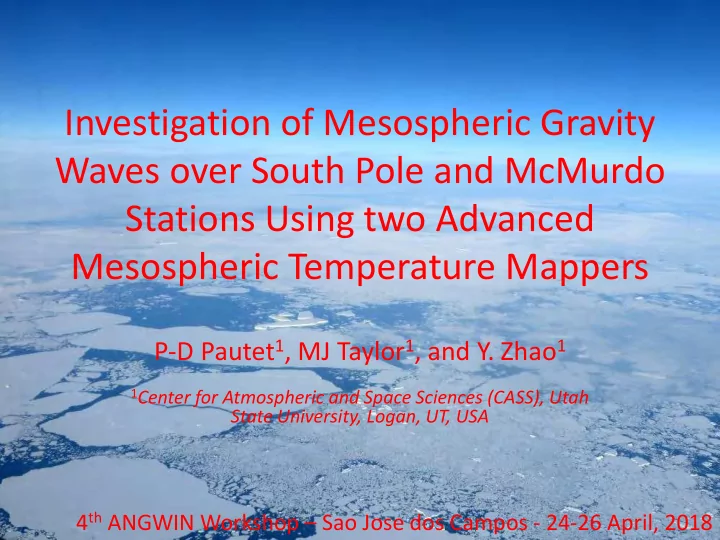

Investigation of Mesospheric Gravity Waves over South Pole and McMurdo Stations Using two Advanced Mesospheric Temperature Mappers P-D Pautet 1 , MJ Taylor 1 , and Y. Zhao 1 1 Center for Atmospheric and Space Sciences (CASS), Utah State University, Logan, UT, USA 4 th ANGWIN Workshop – Sao Jose dos Campos - 24-26 April, 2018
International ANGWIN Instrument Network ~1300 km
Advanced Mesospheric Temperature Mapper (AMTM) • Capability: High-resolution mapping of gravity wave intensity and temperature field at ~87 km and wave phase relationship. • Temperature precision/pix ~1-2 K in ~30 sec. • High-latitude capability as emission lines avoid auroral contamination. AMTM at South Pole AMTM at McMurdo since 2010. Operates since 2017. Operates from mid-April to end from mid-March to of August end of September
Nightly Temperature Averages South Pole McMurdo 3-day smoothing
Nightly Temperature Averages Similar temperatures and large scale (planetary waves?) perturbations Are large scale waves also observed over both sites?
Long-Period (2-12hrs) Waves over Antarctica Temperature precision: 1K May, 2011 • Continuous large amplitude oscillations (>10K) during the whole winter!
Spectral Analysis Lomb Scargle Periodograms 700 700 700 2011 2011 2012 2013 600 600 600 Semi- Normailzed Power Normailzed Power 5-9 hour Diurnal? Diurnal? Normalized Power 500 500 500 400 400 400 300 300 300 200 200 200 100 100 100 0 0 0 0 12 24 0 12 24 0 12 24 Period (hour) Period (hour) Period (hour) 20 Temperature (K) Band pass filtered (5-9 hrs) 10 0 -10 2011 -20 120 150 180 210 240 DOY Date • Continuous strong wave activity throughout winter each year to year • Dominant wave periods between 5-9 hrs • Diurnal and semi-diurnal signatures are not strong.
Fe Lidar Observations at McMurdo (Chen et al., 2013; 2016) • Identified as inertia-gravity waves (waves with frequency close the to inertial frequency and therefore affected by the rotation of the Earth) • Periods from ~3 to ~11 h • Lasting up to 45 h • Dominant vertical wavelength 20-30 km • Horizontal wavelength 1000-2200 km • Sometimes several long-period waves simultaneously • Shallow angle of propagation (~1-2°) • Possible sources: unbalanced flows at stratospheric altitude Continuous 50-hr temperature Fe lidar measurements showing persistent 4-9 hr waves
Can we see the same waves over both sites? Inertia-gravity waves observed 1360km apart?
Comparison Between McMurdo and South Pole Courtesy X. Chu Distance ~1360 km 10
MCM Lidar/SP AMTM Temperature Comparison - Jun 29 th , 2011 Courtesy X. Chu Δ t~3hrs
Collaborative Study: Fe Lidar (X. Chu) at Murdo with AMTM at South Pole
AMTM Datasets Comparison June 16-30, 2017
AMTM Datasets Comparison June 16-30, 2017
Comparison Example
Comparison Example Position of maximum correlation Cross correlation between MCM and SP temperature data
Summary - Future Work • Several periods of simultaneous observations between McMurdo and South Pole have been identified for the 2017 winter season • They show a permanent display of IGWs at both site with strong similarities Future work: • Identification of the different IGWs within the observation period (wavelet) • Cross-correlation between the SP and MCM data sets • Measurements of the time difference between the two sites • Determination of the IGW parameters • Comparison with the Fe lidar data when simultaneous measurements occurred • Assessment of the possible sources?
Recommend
More recommend